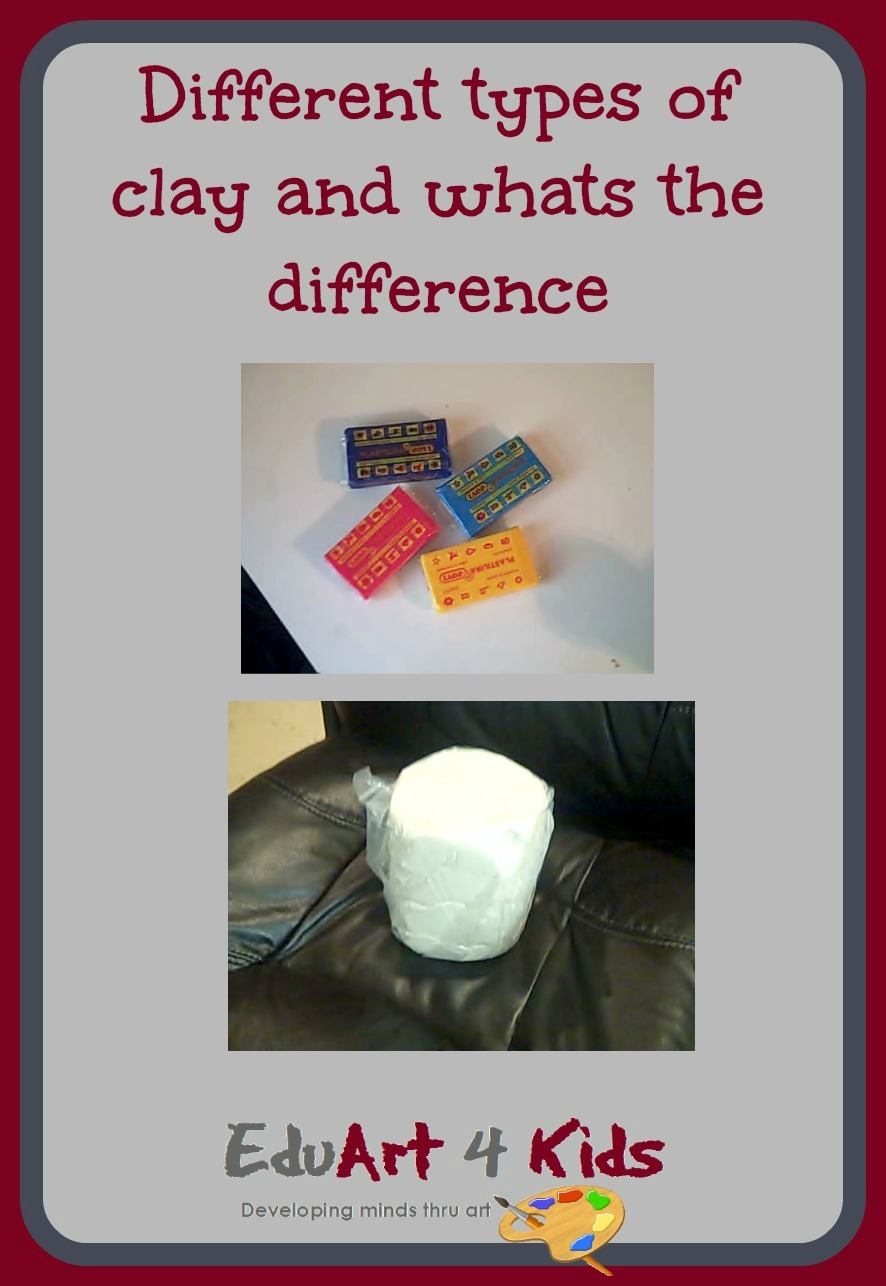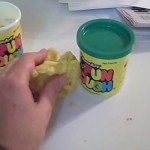
There are many types of clay that you can choose for kids to play and create with.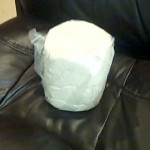
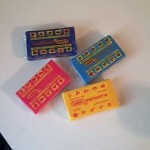
Preschool activities have always had some sort of clay or play dough included in their curriculum and for good reason. Clay is a wonderful activity for all children and even adults.older. (it is even used for art therapy, it is so beneficial) Parents have always found that play doh is a wonderful activity for their kids to do at home and if you are a parent, I would like to broaden your horizons a bit.
I am going to start with the most common one used by parents of young children.
Play dough
Truthfully the real way to write it is Play-Doh but, many people just write it the way is sounds to them which is why is has the word dough in it even though it is not really the way it is spelled.
Play doh is soft and pliable and comes in lots of colors. It smells nice and you do have to be careful that the very little ones don’t eat it. It is quite inexpensive, comes in convenient containers for storage and you can buy many accessories to add to the fun. Play Doh Super Tools is one set you can purchase and they even have a full Play-Doh Creativity Center
that includes lots of play doh and tools to go with it.
The disadvantages of play doh is that it tends to get very piecy when it gets old. It dries out and cracks and crumbles. You can keep any of your creations but you will have to photograph them if you want a memory of it. It also tends to get all over kids hair, carpet and food.
If you really like play doh and want to learn about 39 different ways to use it then you may want to check out this post on 39 ways to play and learn with play dough.
Plasticine
Plasticine has very different properties than play doh and may not be good for younger children. One of the main problems with plasticine is that it is not that soft. It takes a while to become malleable but, once it does it allows for much more detailed modelling than the play doh type of clay. It does not air dry and it’s not the kind of clay that can be fired. When you expose it to heat however, it does melt
Plasticine has been used by animation companies to model their character because it allows them to move in many ways. I remember as a school girl using plasticine to make dioramas, as it retains its shape very well, especially when combined with some wire when sculpting.
For these reasons plasticine may be a clay that is better for children that are not so young, who want to do some real sculpting and modelling.
The plasticine often comes packaged the way the image shows below.
Crayola Model Magic Modeling Clay is probably a great cross between play doh and plasticine.
The only similarities this modeling clay has to play-doh is that you can mold it. This clay is very light and pliable and can be dried. When it dries it does not have the same cracks that appear on the play-doh.It also does not stick to carpets and food and hair like play doh does.
It comes in white and other colors as well. It’s probably a little bit of a better experience to buy it in white so that first the children don’t mix all the colors together. When they do that,the color that is combined is usually a dull, dark one and they lost interest in playing with it. If its white you also have the option to have the children paint their creations or color on them with markers . You can even blend marker colors into the white clay when they are rolling or kneading it.
One complaint about this clay is that sometime when it dries it as a bit of a “foamy” feel especially in humid weather. To keep clay fresh it can be stored in a zip lock bag.
Polymer clay products like Fimo and Sculpey:
I am not going to speak much about polymer clay as I have another post on polymer clay projects that goes into much greater detail. What is important to know is that Fimo Soft Clay and Sculpey
are the most popular of the polymer clay products. They are firm and smooth, do not crumble, and don’t dry out when exposed to air and needs to be baked,
Air dry clay
The last group of clay that I am going to talk about are the water based clay, of which there are a few types.
As an early childhood educator I had always use what we called simply “gray clay”

It’s what I was introduced to in graduate school in my art for kids class and in my post clay modelling for kids you can read how to store and some projects to make with it.
This gray modeling clay hardens naturally so you can avoid the firing process. (it comes in white and red as well) It is basically a self-hardening clay or air dry clay. No kiln or oven firing is necessary. I’ve always bought it in 25 lb blocks but, then discovered that you can buy it in groups of smaller chunks as seen below.
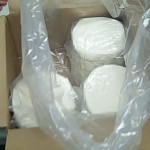
This self hardening clay is an extremely sensory experience for children and mostly comes in large blocks or pieces. It needs to be cut with a piece of string or wire as shown above. I know Marblex sells it and it comes in the amounts below:
AMACO Marblex Self-Hardening Clay, 2-Pound, Grey
AMACO Marblex Self-Hardening Clay, 5-Pound, Grey
Amaco Marblex Clay 25lb
If you working with a group of children you should most definitely buy the 25 lb as it goes quickly.
Remember that this is NOT clay that you bake.It gets used, stored to use again one day or left out to dry.
The cool thing about this kind of clay though is that you can reconstitute it by smashing it down (through a plastic) with a hammer when its already hard and letting it soak for a few days in water.
Aside from the pounding and pinching and rolling and all the things they can do to the clay, its an EXCELLENT form of art therapy. You should be aware that the children can get quite dirty with this clay. It is also important to not that you should never wash out this clay in a sink as it will clog the drains. Instead you need to have buckets nearby for the children to wash up in.
A child is angry or frustrated, or wants to pull out his sisters hair, let him or her at that clay.
There is another kind of air dry clays called Crayola Air Dry Clay . It is not as messy as the gray clay/. My feeling is that children need and love to get messy but, if you can’t stand the dirt and the mess and want air dry clay than this should work for you.
It is supposed to stay moist and soft but there have been cases where the lid was on tight and when it was opened again the clay was dried out and moldy.
Kids like that this dries fast and you can stop the drying process by softening it a bit with water. Without being a clay that can be fired it has a pretty similar finish when done. Paints go on really well on it when dried.
Some people may find the quick drying annoying as it leaves little time for smooth molding. One reviewer for this product noted that even after water was added making a muddy mess, the joints still didn’t hold together and the parts were falling off all over the place.
Porcelain clay
I had an interesting experience recently. I have lately gotten involved in the Reggio Emilia method of early childhood education and was reading a book The Language of Art: Reggio-Inspired Studio Practices in Early Childhood Settings. In the clay section she was writing about a clay that I knew nothing about. Porcelain clay. Even though it seemed very similar to the gray clay I was used to, it seems somewhat different. The author describes it as ..
“a fine-grog white clay, smooth and soft, yet also quite dense. Fired in a kiln porecelain clay harden to a lasting durability”.
Its a natural clay that potters and ceramic artist use, softens when touched with water and also dries when exposed to air. Its an exquisitely white color when it’s unfired. It gets even whiter after firing. If you have access to a kiln I would definitley try out this. She also says that the children don’t get as dirty with this clay as they do with the gray clay and usually are only left with a fine, white powdery dust. It is however, more expensive than the gray clay.
Porcelain Clay – 50 lb, Porcelain Clay
If it dries without hardening and you don’t have access to a kiln then go ahead and try it. I hope to in the near future as well.
Art clay supplies & clay modelling tools
There is no question that hands and fingers are the most important part of the modeling and sculpting process. There does however come a time that kids would like to use tools and accessories to help finish off their pieces. They may not need a Professional Clay Tool Kit but, there is a great set of tools that is really inexpensive that kids can use for any of the clays above. It is the 8 Pc Pottery Tool Set
and is extremely inexpensive and a great addition to clay work.
The kids will need some time to learn to use these implements but if they get really serious about sculpting, they will soon not be able to work without them.
The children must be trained to wash the tools off after the finish working with them so that the clay does not dry on them making it difficult to remove and use the next time.
Where to buy clay
Clay can be bought in many types of venues. Of course, anything can be bought online through any of the links above usually through Amazon. If you want to buy clay locally then just be aware that not all establishments will have the type of clay that you’re looking for. Most of the big box stores and toy stores will have the more standard play doh and crayon types of clay. If you want the more professional stuff including tools then you will have to go specifically to an art store.
What has been your experience in giving children clay? Do you love it or can’t stand it?
Pin to save for later




